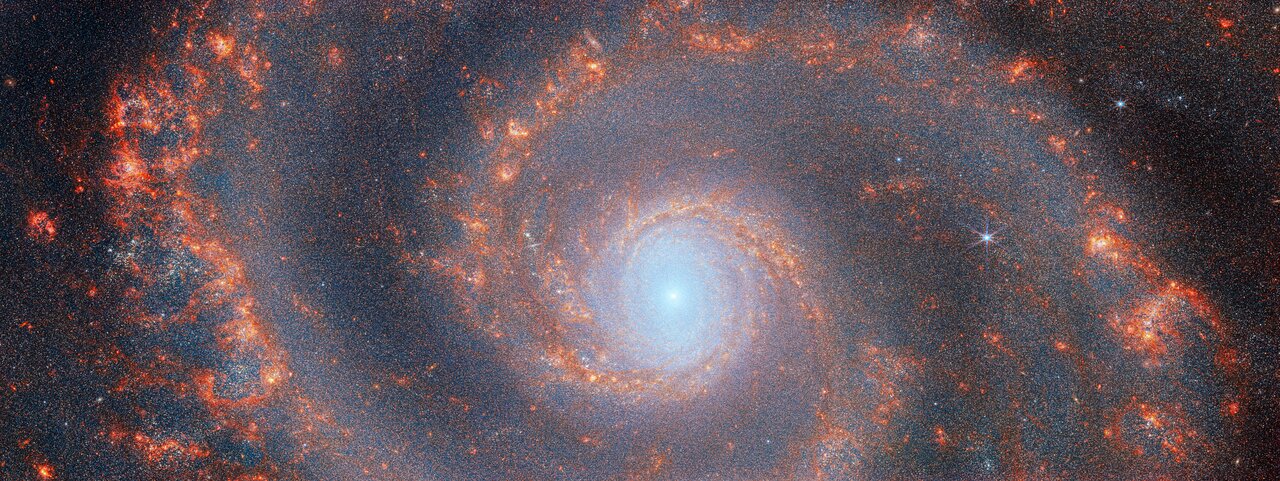The JWST has captured an incredible new image of the Whirlpool galaxy, a “grand-design” spiral galaxy locked in a tumultuous relationship with its neighbor, the dwarf galaxy NGC 5195. Astronomers have been waiting for this day ever since Hubble first imaged it, and it does not disappoint.
Officially named Messier 51, M51 was the first galaxy to be classified as a spiral galaxy, although it’s technically a “grand-design” galaxy rather than your standard one. You’ve probably seen the glorious Hubble images of its perfect spiral arms, a striking hallmark of these types of galaxies. Located just 27 million light-years away from Earth, its incredible face-on view makes it an excellent study for both classic spiral galaxy structure and star-forming processes.
JWST’s new image has shed even more light on the star-forming process as part of a series of observations improbably named FEAST (Feedback in Emerging extrAgalactic Star clusTers) designed to discover and study stellar nurseries beyond our galaxy. JWST, which uses infrared, can see further through the gas and dust where stars form than any telescope before it, so can detect these star-forming regions much further away.
The new images were taken using JWST’s NIRcam and MIRI instruments. In the NIRcam (Near Infrared Camera) image below, the dark red features are warm filamentary dust, according to the European Space Agency (ESA), while the lighter yellow and orange areas are gas ionized by recently formed star clusters.
M51 imaged by JWST’s NIRCam instrument. by JWST’s MIRI instrument.
Image credit: ESA/Webb, NASA, CSA, A. Adamo (Stockholm University) and the FEAST JWST team
In contrast, MIRI (Mid-Infrared Instrument) sees light in the mid-infrared region of the electromagnetic spectrum, which captures the starlight reprocessed by dust and grains to illuminate the filaments much more dramatically. “Empty cavities and bright filaments alternate and give the impression of ripples propagating from the spiral arms. The yellow compact regions indicate the newly formed star clusters in the galaxy,” ESA said in a statement.
M51 imaged by JWST’s MIRI instrument. by JWST’s MIRI instrument.
Image credit: ESA/Webb, NASA, CSA, A. Adamo (Stockholm University) and the FEAST JWST team
A “grand-design” galaxy may sound like an argument for a higher cosmic being, but it really alludes to nature’s “grand design”. It refers to a rarer (just one-in-ten) type of spiral galaxy with strong, defined arms that stem from a clear central region instead of patchy or odd-shaped arms. There is, of course, a scientific reason for it. In M51’s case, it is likely its neighbor – dwarf galaxy NGC 5195, which can be seen in the Hubble image below at the end of one of the spiral arms – that gives it its perfect shape.
“The gravitational influence of M51’s smaller companion is thought to be partially responsible for the stately nature of the galaxy’s prominent and distinct spiral arms,” ESA explained.
“Squabbling” galactic neighbors M51 and dwarf galaxy NGC 5195 (yellow) as taken by Hubble in 2005.
Image credit: NASA, ESA, S. Beckwith (STScI), and The Hubble Heritage Team (STScI/AURA)
Ever since Hubble captured this extremely good-looking galaxy, astronomers have wondered what it may look like as seen by JWST. Now we know, and you could say it was worth the wait.
Source Link: JWST Captures Hypnotic Whirlpool Galaxy In Its Gaze
